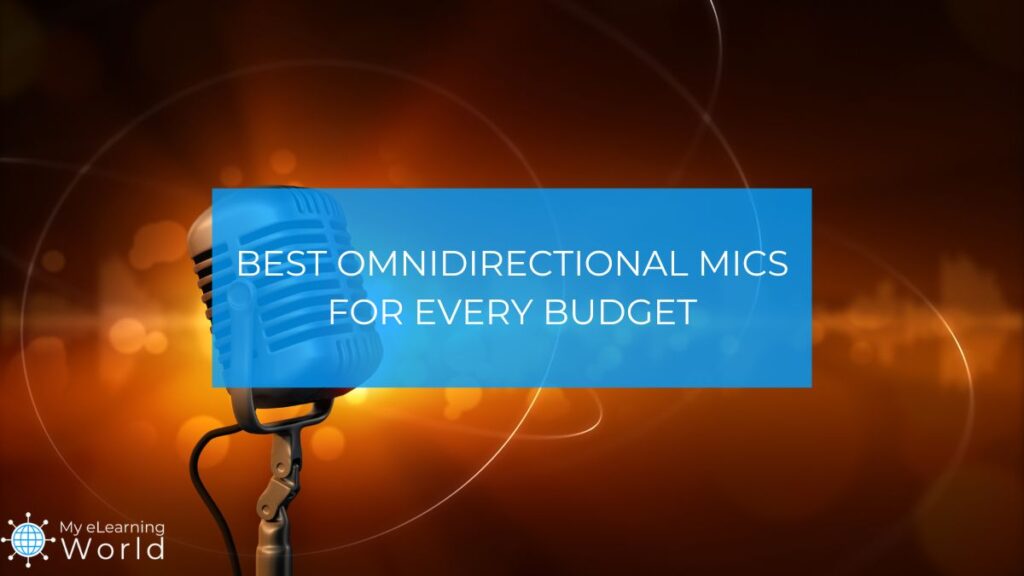The best omnidirectional microphones can be used in a variety of applications to help you capture great sound.
Recording audio is not a one-size-fits-all job. Depending on your needs, you’ll likely want to have a number of different types of microphones available to ensure you get the clearest audio possible in-studio and in the field.
While condenser and dynamic devices can produce great results, it’s also a good idea to have omnidirectional model options available as well.
Omnidirectional microphones are a popular choice among recording professionals because they are very versatile and provide high-quality audio recordings. They pick up sound from all directions at the same time which means that you can capture audio from any angle.
The type of mic you select should also be partially based on the content you create.
For example, if you’re recording YouTube content or a podcast, you might need a desktop USB condenser model, but if you’re recording a live presentation on stage, a dynamic model might work better.
Of course, you also need to factor in your budget (do you need to buy multiple microphones?), your recording environment and more in order to get the right choice for your specific needs.
I’ve reviewed and ranked the best omnidirectional microphones available in 2023, having spent years testing dozens of different models. The guide below includes picks for all budgets, so you’re sure to find one that’s just right for your needs.
Disclosure: Some of the links in this article are affiliate links, meaning at no additional cost for you, we might get a commission if you click the link and purchase.
Quick Picks for the Best Omnidirectional Mics
Don’t feel like reading our full guide? Here are some quick picks for the omnidirectional microphones I feel are the very best of the best.
 Blue Yeti USB Mic for Recording & Streaming on PC and Mac
Blue Yeti USB Mic for Recording & Streaming on PC and Mac
What’s inside?
- 4 different pattern modes
- USB plug-and-play compatibility
- Works with all major recording software
- Zero-latency monitoring
- Excellent audio quality
- Affordable on nearly any budget
The Blue Yeti also came in at the top of my list because it can be used in almost any setting and still look good. Whether you’re recording YouTube videos, showing off your home studio to friends or you’re broadcasting live and you want to look your best, the Blue Yeti comes across as sleek and modern with a hint of old-world charm. I find that it sticks out from the crowd without drawing too much attention to itself, and this can give you the chance to focus on your set design without having to worry about your microphone stealing the show.
 Professional Grade Lavalier Lapel Microphone Omnidirectional Mic with Easy Clip On System
Professional Grade Lavalier Lapel Microphone Omnidirectional Mic with Easy Clip On System
What’s inside?
- High-sensitivity capsule for detailed recording
- Reduces wind and background noise
- Compatible with smartphone recording apps and more
- Ultra-portable
- Easy to hide during on-camera recording
Killer feature: Portability for studio and remote recording
Another reason why I found the PowerDeWise lavalier microphone model to be a fantastic choice is because it offers plenty of room to move around. Many lavalier models have short cables that force you to use a wireless system. This might not be a problem, but it can limit your options, especially if your budget is tight. PowerDeWise provides not only six-and-a-half feet of cabling attached to the device itself, but you can also use the included extension cable for six-and-a-half feet more. This gives you 13’ of freedom to move without having to spend more money on extra equipment.
How to Choose the Right Omnidirectional Microphone
It can be easy to feel overwhelmed by microphone choices, especially if you’re just starting out in the world of recording. There are a lot of new terms to learn, and there are also a lot of picks to choose from that all claim to be the perfect fit for your needs. Thankfully, there are only a few things to think about when it comes to your recording needs in order to find the right choice.
I’ve broken down some things to consider below:
What Kind of Content Will You Be Recording?
When considering the right choice for your needs, you’ll first want to think about the type of content you’ll be creating. Not all models are best for all situations, and just because one mic shines in one situation does not mean it will work well in others.
When recording the human voice, condenser models are often best. This is the case when you’re recording YouTube videos and podcasts that feature discussion or a presentation by one person or perhaps two. Condenser models are also good for capturing fine details in environmental noise and ambient sounds, but you have to be careful as a high level of detail can lead to unwanted artifacts in your recording.
For recording live sound or loud instruments, dynamic models often work best. Dynamic models are less sensitive and can handle louder sounds much easier than condenser ones. You would also want to choose a dynamic device if you’re recording audio in a live environment with a lot of noise. These devices tend to be the most viable option when you need to hold a mic while recording or when it needs to be passed around during recording.
For group recording, omnidirectional models work best. In some cases, omnidirectional polar patterns are selectable on condenser ones with the flip of a switch, but other microphones are designed as dedicated omnidirectional devices.
Omnidirectional models can be found in both dynamic and condenser form, but most will utilize condenser capsules since these types of microphones are usually configured as lavalier clip-on ones. A lavalier omnidirectional models can offer a greater degree of freedom and movement when recording a single presenter, but omnidirectional models can also be table-top for sound capture in a round-table environment.
What’s Your Budget?
Budget is a major deciding factor in choosing the right device no matter what your experience level. Everyone wants to save money, so it only makes sense to look for the least expensive choice to get the job done right. While some expensive models have a high price tag for a reason, price doesn’t always equate to quality. There are plenty of budget devices available that can deliver clear audio without breaking the bank.
What Type of Microphone is Best?
You also need to think about what type of device you’re looking for based on the content you’re creating and your budget. Below are some of the most common types of devices and their uses:
Condenser Mics
As stated, condenser models have a high degree of sensitivity, and this makes them useful for capturing natural sounds like the human voice. A condenser model is best suited for studio work due to the aforementioned sensitivity, and these models may produce distortion when recording in very loud environments. When positioning a condenser device, you’ll usually want to either mount the mic or use it along with a dedicated mic stand. Due to the sensitivity of a condenser model, holding it in your hand while recording could lead to vibrations and unwanted noise in your final recording.
Dynamic Mics
Dynamic devices are less sensitive and will not create a distorted signal nearly as easily. This is especially true when you utilize them alongside an audio interface with input gain control. Dynamic devices are often handheld by design since they do not pick up as much handling noise when compared to condenser devices, so they work well on-stage.
Omnidirectional Mics
Omnidirectional devices capture audio from all around instead of from a singular direction. These types of microphones are beneficial when used in a group setting where a device needs to capture multiple sounds from different directions at once. Additionally, omnidirectional models are the go-to option when using a lavalier lapel devices setup so that that person wearing the mic can move around freely. An added benefit is that you don’t have to focus as much on positioning an omnidirectional device since it will capture sounds evenly from different directions.
Where Will You Be Recording?
Your recording environment is just as important as the content you’re recording because the recording environment will determine the type of mic you need, and therefore, it can also affect your budget. When recording in a studio environment, consider investing in acoustic treatment for walls, floors and ceilings to reduce reflections. If you’re recording in a live environment, you’ll want to account for environmental noise as well as the weather. Even a slight breeze outdoors can cause a lot of noise when you listen back through a recording later.
I also want to add special note about omnidirectional microphones and environment. Omnidirectional models are designed to pick up sound from all directions. This can be an advantage when you can control your recording, environment, but it can cause a lot of trouble when you’re recording in an uncontrolled acoustic space. Keep in mind that omnidirectional models can also introduce reverb due to reflections that bounce off of various surfaces, so you need to control for these variables as well.
Best Conditions for Omnidirectional Mics
- Indoor studio spaces with acoustic treatment
- Outdoor spaces where crowds are kept far from the device
- Indoor or outdoor spaces while using a wind screen
Worst Conditions for Omnidirectional Mics
Windy outdoor spaces or outdoor spaces where environmental noise is louder than your talent
- Indoor spaces where device placement is far from your audio source
- Indoor or outdoor spaces where an unsecured omnidirectional lavalier model causes handling noise
I put together the best omnidirectional models in this list. You can choose the models you need according to the most suitable category.
What are the Best Omnidirectional Microphones?
Here are my picks for the best omnidirectional mics in 2023…
 |
Best for video chat and conference calls, including services like Zoom and Skype. Category: Under $50
|
Amazon →Tonor → |
 |
Best for YouTube content creators, podcasters, voiceover artists and studio musicians Category: Under $50
|
Amazon →Jlab → |
 |
Best for interviews and on-the-scene reporting. Category: Under $50
|
Amazon → Movophoto → |
 |
Best for podcasting and interviewing. Category: Under $50
My choice among budget microphones!
|
Amazon → |
 |
Best for interviews and environment capture. Category: Under $50
|
Amazon → |
 |
Best for Podcasters and YouTubers. Category: Under $100
|
Logitech→ |
 |
Best for YouTubers who want to make a statement on camera while still getting clear, crisp audio from a recording. Category: Under $100
|
Amazon →Blue → |
 |
Best for podcasting and recording vocals. Category: Under $300
My choice among condenser microphones!
|
Logitech→ |
 |
Best for gamers, streamers, YouTubers and more. Category: Under $300
|
Amazon →HyperX → |
 |
Best for high-end sound recording of instruments like cymbals, piano and woodwinds. Category: Under $300
|
Amazon →Reverb → |
 |
Best for interviews and presentations. Category: Under $300
|
Amazon →SweetWater → |
 |
Best for YouTube content creators, live presenters, indie film makers and more. Category: Under $300
|
Amazon →Sennheiser → |
 |
Best for YouTube presenters and live podcasters who need to record in a group. Category: Under $300
|
Amazon →Reverb → |
Because I get asked often about which are the best omnidirectional models, I decided to thoroughly test a number of products that have been recommended recently. My testing included a run through of all features, audio testing with comparisons and testing for reliability and durability. I also factored price into my reviews and broke down my results into several price points to help you make a smarter decision for your money.
Omnidirectional Microphones Under $50
Check out the cheapest models of my list!
1. TONOR G11
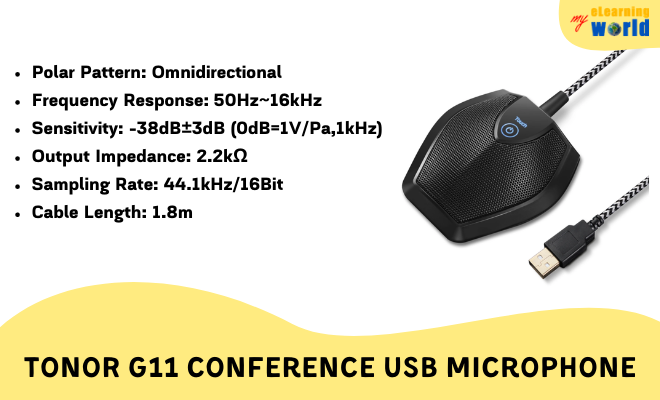
Although omnidirectional devices are often used to capture audio from a single source, these models are also excellent for use in conference calls or group recording sessions that have sound coming from various directions at once. TONOR’s Conference USB microphone provides a solution for these needs by offering clear audio capture from up to 11’ in any direction. The TONOR G11 mic also provides fast and efficient connectivity with any recording device that utilizes USB input, and this makes it easy to transport, set up and use in multiple locations for on-the-go audio professionals.
Features:
- Optimized for audio and video conferencing using tools like Zoom, Skype, Hangouts and other popular virtual conference platforms
- Include onboard mute button with indicator light for better control over audio
- Utilizes USB with no additional drivers required for quick set up and portability
Pros:
- 360 degrees of sound capture for clear recording in a group setting
- Stylish, discreet design works with most modern office and studio decor
- Shielded cable reduces signal noise interference
Cons:
- Does not include a built-in speaker or monitor jack
- Can only position on flat surfaces
- May need extension cable depending on recording environment

Best For:
- Video and audio conference recording and voice transmission
- YouTube content creators and podcasters who need omnidirectional recording in a group setting
Check out GoTechGeek’s review on YouTube to see and hear the TONOR G11 in action.
Buying Options:
2. JLab Audio Talk GO

There are plenty of omnidirectional models out there that can get the job done, but if you really want to capture broadcast-quality audio, you need the JLab Audio Talk GO. This model features a compact design for easy travel, but it also records at a stunning 96k/24-bit for some of the highest audio quality in the recording industry. I found that the JLab Audio Talk GO performed great in studio for podcasting, but it can also be used for tabletop recording of YouTube content.
Features:
- Frequency response ranges between 20Hz and 20kHz to capture low bass tones and crisp high-end sounds
- Includes the ability to capture sound at a sample rate of 96k for added detail and clarity
- USB-C output provides connectivity with modern recording devices
Pros:
- 24-bit recording can deliver studio-quality audio for easy editing in post
- Includes built-in mute and gain control functions that are accessible on the device itself
- Allows for easy switching between cardioid and omnidirectional polar patterns for use in a variety of recording situations
Cons:
- Cable only measures 5’ which may be too short for some recording environments
- No additional support for bidirectional recording, limiting use for interview tasks
- Higher bit depth and sampling rates only available on more expensive models

Best For:
- YouTube content creators, podcasters and voiceover artists
- Studio musicians who need to record low-volume natural tones
Watch as Ben from JLab Audio provides some easy how-to steps for setting up and using the JLab Audio GO.
Buying Options:
3. Movo HM-M2

The Movo HM-M2 is a dynamic omnidirectional model. This means that it can handle louder sounds due to decreased sensitivity. I found that this one not only captured clear audio when conducting interviews on the street, but it also held its own when I used it to create YouTube content with a presenter. One of the best parts about the Movo HM-M2 is that it uses a standard XLR cable connection, allowing it to be connected with traditional audio interfaces to take full advantage of their audio processing power.
Features:
- Handheld design makes positioning easy when passed between talent
- Dynamic capsule reduces sensitivity, allowing the Movo HM-M2 to be used on the street when conducting interviews and while reporting
- Lightweight balancing makes it easy to hold for long periods of time as the device only clocks in at 6.7 ounces
Pros:
- Versatility in sound capture allows for use in podcasting, studio recording, live interviews and YouTube content creation
- Contains an internal pop filter to reduce unwanted handling noise
- Design displays professionalism for aspiring reporters and citizen journalists
Cons:
- Frequency response is limited to 70Hz-15kHz
- May need an adapter to use with a DSLR camera
- Can not connect to a computer, laptop, or other device for recording through USB

Best For:
- Conducting interviews in the field or between subjects in a studio environment
- Livestreaming reports and citizen journalists
Check out this YouTube video to see Podcastage test the Movo HM-M2 in a variety of different recording situations.
Buying Options:
4. PowerDeWise
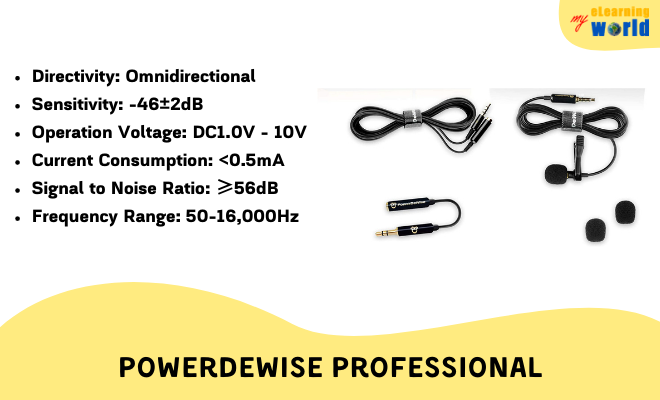
The PowerDeWise lavalier model offers amazing clarity at an affordable price. This model easily connects with a variety of recording devices, including smartphones, and it can be used for podcasting, live broadcasting, YouTube content creation and much more. The device itself clips onto virtually any lapel or collar, and it can be hidden fairly easily with almost any wardrobe choice. Another nice thing about this pick is that it provides a full frequency response for rich bass and crisp highs. If you are recording a variety of speakers, this feature alone makes the PowerDeWise a must-have.
Features:
- Rotating soft-touch clip gives added flexibility in positioning options
- Easily interfaces with smartphones and similar recording devices
- 4-to-3 pin adapter allows this device to be used with DSLR cameras
Pros:
- Full frequency response ranges from 20Hz to 20kHz
- Plug-and-play connectivity when used with many computers and portable recording devices
- Affordable alternative to pricey options that may include unnecessary features
Cons:
- May need an additional Lightning connector to interface with some iPhone models
- 6.5’ cord may be a bit long for some users
- May need official windscreens to replace missing or damaged windscreens included with the device

Best For:
- YouTubers and podcasters who need a recording solution that offers more flexibility in positioning
- Voiceover artists who want to be able to move around while recording
Check out this YouTube video to see HighTechCheck put the PowerDeWise to the test using some common mobile recording devices.
Buying Options:
5. PoP voice PV550+
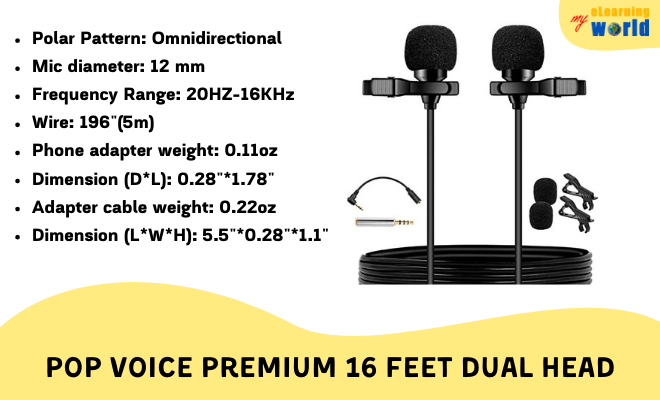
Omnidirectional recording typically works through the polar pattern design of a singular mic. This type of design opens the capsule to receive sounds from all around; however, what if you had two devices that connected to a single cord to capture omnidirectional sound? The answer to that question lies in the PoP voice PV550+ omnidirectional models. Featuring two separate device heads, this product allows for a much great range of freedom in positioning and can result in some creative recordings.
Features:
- 3.5mm jack offers common connectivity with a range of devices
- Affordable price point makes this model accessible on nearly any budget
- Utilizes two microphones to record from multiple sources at once through a single connection
Pros:
- Long cord provides ample room for on-camera talent to move and position
- Dual-head design offers opportunities for creative recording and sound design
- Condenser capsules pick up nuance and detail when recording a more natural sound
Cons:
- May not be compatible with some Android and non-Apple devices
- Possible interference in some recording situations if the device is left plugged in during playback
- Will require a pre-amp to adjust gain
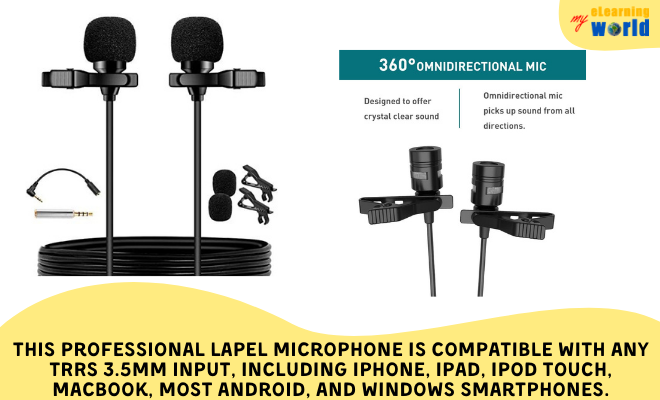
Best For:
- Situations requiring group recording
- YouTube videos and podcasts featuring dialogue
Watch Tobias Holenstein demonstrate the features of the PoP voice PV550+ and test it using some smart devices.
Buying Options:
Omnidirectional Microphones Under $100
These models are not the cheapest ones but better quality has a cost.
6. Blue Yeti Nano

I already love the Blue Yeti and recommend it as my top pick for omnidirectional microphones, but I was really blown away by the Blue Yeti Nano. This compact choice packs a punch by delivering 24-bit recording capabilities as well as the ability to record in both cardioid and omnidirectional modes. The price is also very affordable, and I love that Blue Microphones include a companion app and some processing effects to help newcomers get powerful sound right out of the box.
Features:
- Includes Blue VO!CE vocal effects for enhanced recording and sound output with minimal post-processing
- Small size makes the Blue Yeti Nano easy to use in tight recording spaces
- Includes both cardioid and omnidirectional polar patterns that can be switched on the fly
Pros:
- Perfect for recording content to be uploaded to popular streaming sites, including YouTube, Twitch and Discord
- The device is accessible through the Blue Sherpa app for additional control and processing
- Utilizes zero-latency headphone monitoring for accurate sound
Cons:
- Does not include bidirectional or stereo recording polar patterns
- Sampling rate only available up to 48kHz
- Does not include support for XLR output

Best For:
- Podcasters and YouTubers who want a powerful, affordable recording solution
- Voiceover artists who are looking for an easy plug-and-play omnidirectional model
Check out this Podcastage video to learn more about the Blue Yeti Nano, and see a full rundown of its features and settings.
Buying Options:
7. Blue Snowball

The Blue Snowball was one of the first major USB condenser models to hit the consumer market. Today, this pick still remains one of the best options for fast and easy omnidirectional recording on a budget.
The Snowball design is certainly eye-catching, and it offers easy plug-and-play compatibility with virtually any recording software.
Blue Microphones’ budget-friendly approach to recording is made clear with the Snowball as it’s one of the best values for your money available today. In fact, this one comes in at a price point that is low enough to meet the needs of nearly any budget.
Features:
- Both cardioid and omnidirectional polar patterns available at the flip of a switch
- Easy USB connectivity interfaces with computers, laptops and many digital audio workstations
- Includes a desktop tripod for convenient setup and use out of the box
Pros:
- Affordable option for YouTubers and podcasters who need a simple omnidirectional model
- Polar patterns can be switched on the fly through the device itself
- Can be shock-mounted in-studio or attached to a mic stand through a threaded adapter
- One of the best USB microphones
Cons:
- Form factor may be distracting when used on-camera
- Frequency response range is limited to 40Hz-18kHz
- May need to add gain which can lead to increased signal noise

Best For:
- Podcasters who want a simple and affordable recording solution
- YouTubers who want to make a statement on camera while still getting clear, crisp audio from a recording
See the Blue Snowball in action as Bandrew Scott demonstrates some of its features and recording capabilities.
Buying Options:
Omnidirectional Microphones Under $300
The most expensive models of my list out there! Pay attention to Blue Yeti. It’s my choice among condenser devices!
8. Blue Yeti

Blue Microphones kickstarted the USB condenser mic revolution with the Blue Snowball, and the company continues to innovate in the pro audio space with the Blue Yeti. The Yeti comes in several different models that meet different needs across the spectrum of users. The base Blue Yeti features plug-and-play USB connectivity that offers recording at 16-bit depth and a 48kHz sample rate. You can also select from four different polar patterns from the Yeti by using the onboard control to change between cardioid, bidirectional, omnidirectional and stereo.
Features:
- Three 14mm condenser capsules
- Onboard headphone amplifier for zero-latency monitoring
- Full frequency response across the 20Hz-20kHz spectrum
Pros:
- Built-in gain controls for easy adjusting on the fly
- Compatible with the Blue Sherpa app
- USB connectivity works with a wide variety of input devices
Cons:
- Mute button may get triggered inadvertently through mishandling
- Loud sounds may cause clipping and distortion
- No XLR support

Best For:
- YouTubers and podcasters who want to look great and get professional, powerful sound from their recordings
- Recording vocal takes and live instruments to get a more natural sound
Hear the Blue Yeti for yourself in this YouTube video. Andy Slye demonstrates some of its features and also provides audio examples.
Buying Options:
9. HyperX QuadCast

If you’re looking for an omnidirectional model that looks as good as it sounds, then you’re looking for the HyperX QuadCast. The QuadCast features a stunning design that incorporates a number of LED lighting options for added attention on camera. When it comes to sound, the QuadCast boasts recording quality that reaches up to 16-bit and a sampling rate that clocks in at 48kHz. You can also place the device in a shock mount for added insulation from unwanted noise resulting in sharper audio and less need for post-processing.
Features:
- Unique lighting effects that can be programmed and personalized through HyperX’s NGENUITY software
- Onboard gain control offers the ability to make adjustments as needed
- Built-in headphone jack for convenient monitoring while recording
Pros:
- Includes an internal pop filter to reduce unwanted pops, clicks, and hisses
- Provides the ability to switch between four different polar patterns, including cardioid, bidirectional, omnidirectional, and stereo
- Studio-grade sound quality at an affordable price
Cons:
- Lighting effects may be distracting on camera
- Tap-to-mute function may get triggered by accident during normal use
- LED lights may be difficult to replace if damaged or malfunctioning

Best For:
- Gamers who stream content in a group setting
- YouTube content creators who want to make a bold statement while getting excellent audio capture
Hear audio examples and get a full breakdown of the HyperX QuadCast in this YouTube brought to you by RandomFrankP.
Buying Options:
10. CAD Audio Equitek E70

If you want options in an omnidirectional model, CAD Audio provides them with the CAD Audio Equitek E70. CAD Equitek features the ability to change out your preferred capsule with a choice of three separate options. This means that you aren’t stuck with a single built-in pattern, making the E70 versatile and agile for recording different sounds in different environments. Additionally, the E70 can capture audio that ranges from 20Hz up to 20kHz, and it also incorporates a three-position hi-pass filter for taming top-end sounds.
Features:
- Interchangeable capsules that deliver more choice in recording
- Selectable filter and padding options for more control over volume and tone
- Gold-sputtered diaphragm adds to high-end sound control and reduces harshness
Pros:
- Custom tuning lends itself to accuracy in high-end sound reproduction
- Transformerless design can reduce low-end distortion at high volume levels
- Uses XLR connection and can access phantom power
Cons:
- Features may be a bit much for someone who needs a device for YouTube content creation
- Price may be out of reach for beginners and hobbyists
- Lack of low-end response could wash out bass tones

Best For:
- High-end sound recording of instruments like cymbals, piano and woodwinds
- Vocal recording in a studio environment or group setting
Booth Junkie shows off the features and capabilities of the CAD Audio Equitek E70 alongside other models so you can hear the difference for yourself in this YouTube video.
Buying Options:
11. RODE Reporter

If you need to interview subjects or capture the environment when presenting in front of a camera, you want the RODE Reporter. Designed to look and function just like a traditional reporter’s choice, the Reporter even includes a detachable mic flag to add to your professional image. This device has been specifically tuned to accentuate vocal tones, but it also incorporates the time-tested basket design using woven mesh to reduce wind and other unwanted noise. This can help you capture more of the audio you want without having to spend a lot of time in post correcting audio problems.
Features:
- Frequency response is tailored to the human voice at 70Hz-15kHz
- Utilizes XLR connection for use with a wide range of professional recording gear and interfaces
- Dynamic omnidirectional capsule stands up to loud sounds while still capturing clear audio from 360 degrees
Pros:
- Basket is constructed of layered mesh for reduced wind noise
- Includes detachable mic flag and case
- Offers professional appearance and lends to credibility
Cons:
- Lack of low-end response can cause bass tones to be muted
- No USB connection available
- Does not include onboard monitoring option

Best For:
- Journalists and citizen reporters
- Interviews featuring multiple subjects
In this YouTube video, Podcastage demonstrates the RODE Reporter and records audio samples so you can hear its features in action.
Buying Options:
12. Sennheiser ME 2-II

The Sennheiser ME 2-II has been specifically designed to be used with battery packs, transmitters and portable digital audio recorders. It connects through a mini jack and can capture audio from 50Hz up to 18kHz, making it perfect for capturing vocal performances. Sennheiser is known in the audio industry for making some of the most respected products, and the ME 2-II delivers on the Sennheiser promise of quality by utilizing a permanent polarized condenser capsule. This allows ME 2-II to perform flawlessly time after time at a consistent level.
Features:
- Includes a mini jack for use with battery packs and transmitters
- Small form factor makes it easy to position discreetly
- This one has been tuned to optimize human voice intelligibility
Pros:
- Frequency response cuts off at 18kHz to reduce harsh top-end sounds
- Includes 5’ cable, metal wind screen and lapel clip
- Small form factor allows the device to be placed on chest discreetly
Cons:
- Will need accessories to fully utilize the device to its potential
- Lack of bass response could cause low-end sounds to be lessened
- Does not connect via USB or XLR directly from the device

Best For:
- On-camera presenters and YouTube content creators
- Live presentations where freedom of movement is key
Check out this YouTube in which Kevin Muldoon demonstrates the audio capture capabilities of the Sennheiser ME 2-II using a Zoom portable digital recorder.
Buying Options:
13. Sony ECM-44

Sony is known for creating some of the world’s best electronics, and the brand’s ECM-44 is no exception to the Sony name. This model features an omnidirectional capsule lavalier microphone design that is perfect for discreet placement. Sone ECM-44 has been specially tuned to accentuate the human voice, making it ideal for presentations and general conversation on camera. Sony also includes a protective case for added security and a wind screen for reducing unwanted noise with the ECM-44.
Features:
- Omnidirectional capsule has been tuned to emphasize the human voice
- XLR connection for use with many pro-audio interfaces
- Available in four different models with additional connection types
Pros:
- Can be powered using a single AA battery for 6,000 hours of use
- Professional appearance for use on camera
- Includes 9.8’ cable for more freedom of movement
Cons:
- No option for USB connectivity
- Frequency response only ranges between 40Hz and 15kHz, so deep bass tones may be washed out
- No phantom power option available

Best For:
- YouTube presenters and live podcasters who need to record in a group
- On-stage sound capture
Want to see the Sony ECM-44 in action? Watch this YouTube video to see Andrew from T is for Tech demonstrate some of its features, and listen as he shows off its audio recording capabilities.
Buying Options:
Useful Resources
- Microphone polar patterns
- Directional vs. omnidirectional microphones
- Six reasons to use an omnidirectional mic instead of a unidirectional
- Everything you need to know about omnidirectional microphones
- What is a condenser microphone?
- How do wireless microphones work?
A Final Word on the Best Omnidirectional Mics
No matter what omnidirectional microphone you choose, it’s clear that omnidirectional devices are a necessity for anyone who is serious about having the right recording tools for the right recording task.
I also want to reiterate that you don’t need to focus as much on price when choosing the right device.
While it’s true that more expensive models can provide quality results, there are plenty of budget microphones out there that can deliver top-quality results at a greatly reduced price. These models are even easier to use in some cases since they are designed to be simple.
At the end of the day, it’s all about finding the right microphone for your specific application. With so many great omnidirectional microphones out there, you are sure to find a model that will fit your needs and budget perfectly.
Have any questions about our guide to the best omnidirectional microphones? Let us know by leaving a comment below.
- Elevating Your Virtual Presence: Why EMEET’s SmartCam S800 Stands Out in Modern Communication - 06/04/2025
- US Teachers Will Spend $3.35 Billion of Their Own Money on Classroom Expenses in 2025-25 School Year - 06/04/2025
- Report: Leveraging AI Tools Could Help US Teachers Avoid $43.4 Billion of Unpaid Overtime Work - 06/04/2025
